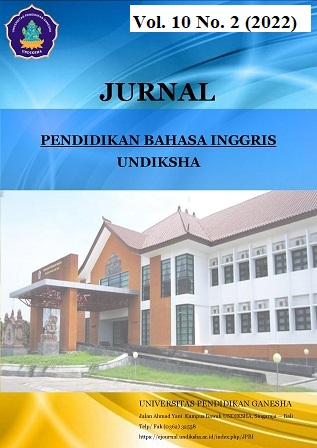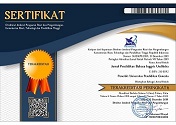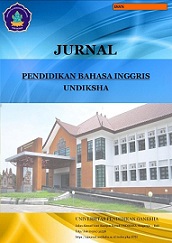Teaching Strategies Used to Deal with Dyslexic Students’ Learning Difficulties
DOI:
https://doi.org/10.23887/jpbi.v10i2.45661Keywords:
Dyslexia, Teaching Strategies, Learning DifficultiesAbstract
Dyslexia is a hereditary, neurodevelopmental learning disorder found to appear in around 10% of the population, characterized by difficulty in reading. Therefore, it needs to be addressed properly by implementing appropriate teaching strategies that can help dyslexic students to learn in the inclusive education setting. However, there is still limited study that provides literature related to the matter. Therefore, this study was a conceptual research aimed to analysing teaching strategies used to deal with the learning difficulties encountered by dyslexic students and provide descriptions related to the dyslexic students’ characteristics along with their learning difficulties. This study is a kind of literature review through library research.The result found that there are four teaching strategies that teachers can use to deal with dyslexic students’ learning difficulties, which are task analysis, explicit phonics instruction, multisensory instruction, and field-dependent approaches. The strategies are adjusted to the characteristics and learning difficulties faced by dyslexic students that include low phonological awareness, slow working memory, rapid naming difficulty, slow processing speed, and low skills automatic development. The strategies emphasise on providing clear, direct instruction with multiple aids and assistance from the teachers. The use of several accommodations are also needed in order to help the dyslexic students to develop their reading skill and deal with their learning difficulties.
References
Ackah-Jnr, F. R. (2020). Inclusive education, a best practice, policy and provision in education systems and schools: The rationale and critique. European Journal of Education Studies, 6(10), 171–183. https://doi.org/10.5281/zenodo.3605128.
Al-Shidhani, T. A., & Arora, V. (2012). Understanding dyslexia in children through human development theories. Sultan Qaboos University Medical Journal, 12(3), 286–294. https://doi.org/10.12816/0003141.
Awada, G., & Plana, M. G. C. (2018). Multiple strategies approach and EFL reading comprehension of learners with dyslexia: Teachers’ perceptions. International Journal of Instruction, 11(3), 463–476. https://doi.org/10.12973/iji.2018.11332a.
Budiarti, N. D., & Sugito, S. (2018). Implementation of Inclusive Education of Elementary Schools: a Case Study in Karangmojo Sub-District, Gunungkidul Regency. Journal of Education and Learning (EduLearn), 12(2), 214–223. https://doi.org/10.11591/edulearn.v12i2.8727.
Catts, H. W., McIlraith, A., Bridges, M. S., & Nielsen, D. C. (2017). Viewing a phonological deficit within a multifactorial model of dyslexia. Reading and Writing, 30(3), 613–629. https://doi.org/10.1007/s11145-016-9692-2.
Colson, J. (2014). Teacher Training on Teaching Students with Dyslexia. Intervention in School and Clinic, 10(31), 105–345. https://doi.org/10.33015/dominican.edu/2013.edu.23.
Dambayana, P. E., Pratiwi, N. P. A., & Saraswati, N. K. R. (2021). An analysis of students’ reading comprehension difficulties of eighth grade students. Jurnal IKA Undiksha, 19(1), 34–45. https://doi.org/10.23887/ika.v19i1.31826.
Denton, C. A., Fletcher, J. M., Anthony, J. L., & Francis, D. J. (2006). An evaluation of intensive intervention for students with persistent reading difficulties. Journal of Learning Disabilities, 39(5), 447–466. https://doi.org/10.1177/00222194060390050601.
Dickie, C., Ota, M., & Clark, A. (2013). Revisiting the phonological deficit in dyslexia: Are implicit nonorthographic representations impaired? Applied Psycholinguistics, 34(4), 649–672. https://doi.org/10.1017/S0142716411000907.
Elleman, A. M., & Oslund, E. L. (2019). Reading Comprehension Research: Implications for Practice and Policy. Policy Insights from the Behavioral and Brain Sciences, 6(1), 3–11. https://doi.org/10.1177/2372732218816339.
Elliot, D. L., Davidson, J. K., & Lewin, J. (2007). Literature Review of Current Approaches to the Provision of Education for Children with Dyslexia HM Inspectorate of Education. May. https://eric.ed.gov/?id=ED539441.
Evans, W., Gable, R. A., & Habib, A. (2021). Lessons from the past and challenges for the future: Inclusive education for students with unique needs. Education Sciences, 11(6). https://doi.org/10.3390/educsci11060281.
Flood, M., & Banks, J. (2021). Universal design for learning: Is it gaining momentum in Irish education? Education Sciences, 11(7). https://doi.org/10.3390/educsci11070341.
Friantary, H., Afriani, Z. L., & Nopitasari, Y. (2020). The Implementation of Indonesian Language Learning for Dyslexic in Children at Elementary Schools in Bengkulu. Linguists : Journal Of Linguistics and Language Teaching, 6(2), 23. https://doi.org/10.29300/ling.v6i2.3750.
Gersten, R., Compton, D., Connor, C. M., Dimino, J., Santoro, L., Linan-Thompson, S., & David Tilly, W. (2014). Assisting students struggling with reading: Response to intervention and multi-tier intervention in the primary grades. Improving Outcomes for Students with or at Risk for Reading Disabilities, 121–190. https://www.trumbullesc.org/Downloads/rti_reading_pg_021809.pdf.
Gregory, R. (2021). Dyslexia in higher education. Educational Research and Reviews, 16(4), 125–135. https://doi.org/10.5897/err2021.4128.
Ha, H. T. (2021). Exploring the relationships between various dimensions of receptive vocabulary knowledge and L2 listening and reading comprehension. Language Testing in Asia, 11(1). https://doi.org/10.1186/s40468-021-00131-8.
Haarbauer-krupa, J. K. (2010). Language and speech predictors of reading achievement in preschool children with language disorders. Dissertation Abstracts International: Section B: The Sciences and Engineering, 71(3-B), 1663.
Harmer, J. (2001). The practice of English language teaching. London/New York, 401–405.
Hermida, D. J. (2011). The Importance of Teaching Academic Reading Skills In First-Year University Courses. SSRN Electronic Journal, 1–12. https://doi.org/10.2139/ssrn.1419247.
Hornby, G. (2021). Are inclusive education or special education programs more likely to result in inclusion post-school? Education Sciences, 11(6). https://doi.org/10.3390/educsci11060304.
Hulme, C., & Snowling, M. J. (2016). Reading disorders and dyslexia. Current Opinion in Pediatrics, 28(6), 731–735. https://doi.org/10.1097/MOP.0000000000000411.
Ismail, H., Syahruzah, J. K., & Basuki, B. (2017). Improving the Students’ Reading Skill Through Translation Method. Journal of English Education, 2(2), 124–131. https://doi.org/10.31327/jee.v2i2.405.
Kauffman, J. M. (2021). The promises and limitations of educational tiers for special and inclusive education. Education Sciences, 11(7). https://doi.org/10.3390/educsci11070323.
Kaya, E. (2015). The Role of Reading Skills on Reading Comprehension Ability of Turkish EFL Students. ÜNİVERSİTEPARK Bülten, 4(1–2), 37–51. https://doi.org/10.12973/unibulletin.412.4.
Keesey, S. (2020). Journal : The Journal of the Teacher Education Division of the Kentucky Council for Exceptional Children Effective Instruction for Students With Dyslexia and Related Learning Struggles. Kentucky Teacher Education Journal: The Journal of the Teacher Education Division of the Kentucky Council for Exceptional Children, 7(1), 3. https://digitalcommons.murraystate.edu/ktej/vol7/iss1/3/.
Kim, Y. S., Wagner, R. K., & Lopez, D. (2012). Developmental relations between reading fluency and reading comprehension: A longitudinal study from Grade 1 to Grade 2. Journal of Experimental Child Psychology, 113(1), 93–111. https://doi.org/10.1016/j.jecp.2012.03.002.
Knight, C. (2018). What is dyslexia? An exploration of the relationship between teachers’ understandings of dyslexia and their training experiences. Dyslexia, 24(3), 207–219. https://doi.org/10.1002/dys.1593.
Krishnan, S., Watkins, K. E., & Bishop, D. V. M. (2016). Neurobiological Basis of Language Learning Difficulties. Trends in Cognitive Sciences, 20(9), 701–714. https://doi.org/10.1016/j.tics.2016.06.012.
Larsen, L., Schauber, S. K., Kohnen, S., Nickels, L., & McArthur, G. (2020). Children’s knowledge of single- and multiple-letter grapheme-phoneme correspondences: An exploratory study. Early Childhood Research Quarterly, 51, 379–391. https://doi.org/10.1016/j.ecresq.2019.12.001.
Law, J. M., De Vos, A., Vanderauwera, J., Wouters, J., Ghesquière, P., & Vandermosten, M. (2018). Grapheme-phoneme learning in an unknown orthography: A study in typical reading and dyslexic children. Frontiers in Psychology, 9(AUG), 1–10. https://doi.org/10.3389/fpsyg.2018.01393.
Lestari, R. P., Fitriani, S. S., & Erdiana, N. (2017). Reading Comprehension Difficulties Encountered By Senior High School EFL Students. Research in English and Education (READ), 2(2), 110–118. http://www.jim.unsyiah.ac.id/READ/article/view/5772.
Lichtman, M. (2013). Qualitative research for the social sciences. Sage Publications.
Manilla, G. T., & de Braga, J. (2017). A New Dyslexia Reading Method and Visual Correction Position Method. Global Pediatric Health, 4. https://doi.org/10.1177/2333794X17734096.
Manset-Williamson, G., & Nelson, J. M. (2005). Balanced, strategic reading instruction for upper-elementary and middle school students with reading disabilities: A comparative study of two approaches. Learning Disability Quarterly, 28(1), 59–74. https://doi.org/10.2307/4126973.
Menbet, A. A. (2018). The Use of Effective Strategies to Improve Saudi EFL Dyslexic Learners’ Writing Skills. Theory and Practice in Language Studies, 8(12), 1611. https://doi.org/10.17507/tpls.0812.06.
Muazza, M., Hadiyanto, H., Heny, D., Mukminin, A., Habibi, A., & Sofwan, M. (2018). Analyses of inclusive education policy: A case study of elementary school in Jambi. Jurnal Kependidikan: Penelitian Inovasi Pembelajaran, 2(1), 1–12. https://doi.org/10.21831/jk.v2i1.14968.
Nimehchisalem, V., & Bhatti, N. (2019). A Review of Literature on Language Assessment Literacy in last two decades (1999-2018). International Journal of Innovation, Creativity and Change, 8(11). www.ijicc.net.
Ningsih, I. H., Winarni, R., & Roemintoyo, R. (2019). The Importance Of Early Reading Learning In The Face Of 21st Century Education. AL-ASASIYYA: Journal Of Basic Education, 3(2), 196. https://doi.org/10.24269/ajbe.v3i2.1879.
Nishanthi, R. (2018). The importance of learning English in today world. International Journal of Trend in Scientific Research and Development, Volume-3(Issue-1), 871–874. https://doi.org/10.31142/ijtsrd19061.
Nurjanah, R. L. (2018). The Analysis on Students’ Difficulties in Doing Reading Comprehension Final Test. Metathesis: Journal of English Language Literature and Teaching, 2(2), 253–264. https://doi.org/10.31002/metathesis.
Prihatini, S. O. (2020). an Analysis of Students’ Difficulties in Reading Comprehension At Sma Negeri 1 Sukodadi Lamongan. E-Link Journal, 7(1), 21. https://doi.org/10.30736/ej.v7i1.261.
Protopapas, A. (2019). Evolving Concepts of Dyslexia and Their Implications for Research and Remediation. Frontiers in Psychology, 10(December), 1–10. https://doi.org/10.3389/fpsyg.2019.02873.
Roitsch, J., & Watson, S. (2019). An Overview of Dyslexia: Definition, Characteristics, Assessment, Identification, and Intervention. Science Journal of Education, 7(4), 81. https://doi.org/10.11648/j.sjedu.20190704.11.
Rosita, T., Alawiyah, T., Rochyadi, E., Indonesia, U. P., & Indonesia, U. P. (2020). Interactive Learning Media. PrimaryEdu: Journal of Primary Education, 4(1), 48–54. https://doi.org/10.22460/pej.v4i1.1618.
Siok, W. T., & Tan, L. H. (2022). Is phonological deficit a necessary or sufficient condition for Chinese reading disability? Brain and Language, 226, 105069. https://doi.org/10.1016/j.bandl.2021.105069.
Snowling, M. J., Hulme, C., & Nation, K. (2020). Defining and understanding dyslexia: past, present and future. Oxford Review of Education, 46(4), 501–513. https://doi.org/10.1080/03054985.2020.1765756.
Stuart, A., & Yates, A. (2018). Inclusive classroom strategies for raising the achievement of students with dyslexia. Teachers’ Work, 15(2), 100–104. https://doi.org/10.24135/teacherswork.v15i2.260.
Sudek, E., & Encinas, F. (2019). Strategies for elementary dyslexic students’ English language learning: Crowdsourcing and reviewing research literature. Mextesol Journal, 43(3). https://www.researchgate.net/profile/Fatima-Encinas-2/publication/336795902_Strategies_for_Elementary_Dyslexic_Students’_English_Language_Learning_Crowdsourcing_and_Reviewing_Research_Literature/links/5db24f8f299bf111d4c1964a/Strategies-for-Elementary-Dyslexic-Students-English-Language-Learning-Crowdsourcing-and-Reviewing-Research-Literature.pdf.
Supriatna, A., & Ediyanto, E. (2021). The Implementation of Multisensory Technique for Children with Dyslexia. IJDS: Indonesian Journal of Disability Studies, 8(01), 279–293. https://doi.org/10.21776/ub.ijds.2021.008.01.17.
Sutton, J., & Shields, M. (2016). Dyslexia: 10 strategies. TEACH Journal of Christian Education, 10(2), 13–22. https://doi.org/10.55254/1835-1492.1321.
Treiman, R. (2018). What research tells us about reading instruction. Psychological Science in the Public Interest, 19(1), 1–4. https://doi.org/10.1177/1529100618772272.
Van Witteloostuijn, M., Boersma, P., Wijnen, F., & Rispens, J. (2019). Statistical learning abilities of children with dyslexia across three experimental paradigms. PLoS ONE, 14(8), 1–29. https://doi.org/10.1371/journal.pone.0220041.
Witruk, E., & Wilcke, A. (2016). Dyslexia – an Overview of Assessment and Treatment Methods. Buletin Psikologi, 18(2), 69–90. http://download.garuda.kemdikbud.go.id/article.php?article=661914&val=7990&title=dyslexia an overview of assessment and treatment methods.
Witzel, B., & Mize, M. (2018). Meeting the Needs of Students with Dyslexia and Dyscalculia. SRATE Journal, 27(1), 31–39. https://eric.ed.gov/?id=EJ1166703.
Downloads
Published
Issue
Section
License
Copyright (c) 2022 Ni Made Indah Purnama Dewi

This work is licensed under a Creative Commons Attribution-ShareAlike 4.0 International License.
Authors who publish with the Jurnal Pendidikan Bahasa Inggris Undiksha agree to the following terms:- Authors retain copyright and grant the journal the right of first publication with the work simultaneously licensed under a Creative Commons Attribution License (CC BY-SA 4.0) that allows others to share the work with an acknowledgment of the work's authorship and initial publication in this journal
- Authors are able to enter into separate, additional contractual arrangements for the non-exclusive distribution of the journal's published version of the work (e.g., post it to an institutional repository or publish it in a book), with an acknowledgment of its initial publication in this journal.
- Authors are permitted and encouraged to post their work online (e.g., in institutional repositories or on their website) prior to and during the submission process, as it can lead to productive exchanges, as well as earlier and greater citation of published work. (See The Effect of Open Access)













